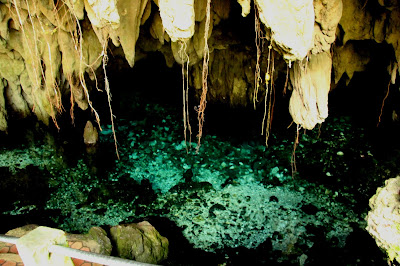For completeness, I'll mention that you also have to clear out of the first port with the Harbour Master 24 hours before you leave. This is not required in any other port you visit along the way in Indo.
In the past Indonesia had a reputation for officials to request what is euphemistically called "tips" to get cleared in. With the new government in place things are much more straight forward. The sign above in the Customs office says: "Customs and Excise, Tual. We are ready to serve wholeheartedly the yachters without receiving rewards." All clearance is free.
There were many presentations, lunches and dinners earlier in the week for the yachts that had cleared in. We made it to the final 'Gala Dinner'. It was held at a large beach area and was probably attended by 1,000 locals, as well as all the yachties. Above is a bamboo flute chorus. We felt a bit like Rockstars. Children, girls, women, grandmas, men all come up and ask if they can take a selfie with us.
This is one of our yachtie friends, Stuart from the sailing catamaran Time Bandit, who gave a wonderful speech thanking the locals for all the hospitality, food and good will on behalf of the yachties. I'm not sure why he is wearing a skirt, but I think it has something to with his homeland of Scotland. He is surrounded by four, young kids who were absolutely perfectly behaved while the speech and its translation into Bhasa Indonesian.
He then gave the head of he Regency a flag signed by all the yachts. Lots of clapping and cheers followed. Then it was time for the dinner which was a potpourri of many homemade Indonesian and Kei Island specialties.
The island is a mixture of Catholic and Muslim, all apparently living together in remarkable friendship. Some families have large branches where one limb is Muslim and the other Catholic. Above is a mosque with a larger fishing boat being built in front.
We rented a cab for the day so we could go into town and get our cellphone SIM cards setup (for the sole purpose of being able to publish this blog). While on the way we took a local teacher with us, Kenny, to show us around the island. We stopped at the local Huan sacred caves, filled with clear water that has percolated down through the limestone. The islands ancestors stop by the caves and reconnect with those who are still among the living.
After harvest it is laid in the sun and dried before being shipped out for further processing and export.
This is what is called a Dutch 'table cannon' here. It is left over from the Dutch colonial times. This one is planted in some concrete to mark an offering plate at the Huan park. The interesting thing about these cannons is that when a man wants to take a bride on the island, it is traditional for him to give the bride's family a table canon as a sort of dowry. These are not replicas, but actual Dutch bronze cannons or guns from the good ole days, say the 1600's. Besides being colonized by the Dutch, these islands were also occupied by the Japanese during World War II from where they conducted air raids on Australia.
Some of the colorful buildings in the main city area of Tual and Langur.
And the traffic jam we created when the taxi driver asked if we wanted to take a picture from the bridge that connects Tual and Langur. He just stopped in the traffic lane (no shoulder) and we got out to click while all these cars and motorcycles had to sneak into the incoming lane to get by. As friendly and helpful as everyone we've met so far has been, I'm still thinking there were more than a few Damn tourist uttered by these drivers.
After getting SIM cards, a stop at the ATM and a great lunch, we headed to the market to get some fresh vegies. Always a colorful event.
Kenny, our guide for the day really wanted to show our boat to some of his family, so we setup for them to come out the next day. Our boat and ourselves are now in a lot of local pictures.
Tomorrow we head of for a small island about 15 miles west of here to try and get in some snorkeling in what is said to be the clearest water around here with good corals. Then in a few days we will do an overnight sail to the Banda islands, the heart of the historic East Indies spice trade and key to many historic world events of the 1600-1800's.
Paul



























































